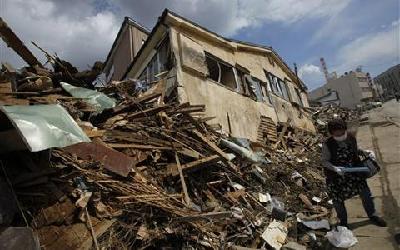
This is the VOA Special English Technology Report.
Builders in developing countries are often not required to build strong buildings. So, when a disaster strikes, the damage is often widespread.
Yet Japan is one of the most developed countries in the world. Still, the March 11th earthquake and tsunami waves destroyed more than 14,000 buildings.
Brady Cox is an assistant professor of civil engineering at the University of Arkansas. He is also an earthquake expert with an organization called Geotechnical Extreme Events Reconnaissance, or GEER. The group studies major disasters.
Professor Cox says Japan has one of the best building-code systems in the world.
BRADY COX: "The problem is this earthquake was just a mammoth earthquake, one of the, you know, top five earthquakes in recorded history. So anytime you have an earthquake that large, you are going to have damage."
The quake measured magnitude nine.
BRADY COX: "One thing I think a lot of people don't understand is that building codes are meant to prevent loss of life in earthquakes, that doesn't mean that the buildings won't -- or bridges for that matter, or anything -- won't sustain significant damage."
Mr. Cox says Japan has invested a lot in seismic research and design since a magnitude 7.5 earthquake in Niigata in 1964. That same year a 9.2 quake shook the American state of Alaska.
BRADY COX: "Those two earthquakes really opened up a lot of new research on something called soil liquefaction, in particular. And, you know, the Japanese, they have more earthquakes greater than magnitude six or seven than probably any other country in the world. I mean, they get hit a lot."
Soil liquefaction is the process by which the strength or stiffness of soil is weakened by an event like the shaking of an earthquake. The soil begins to move like liquid.
Professor Cox says the first step to designing an earthquake-resistant building is to study the soil.
BRADY COX: "Then the structural engineers take that information and they use it to detail the building in terms of, is this going to be a steel structure? Is it going to be reinforced concrete? And then you get into all kinds of things in terms of the designs of the columns and the beams and the framing of the building and the connections. And how much steel do you put in?"
A team from Geotechnical Extreme Events Reconnaissance is planning a trip to Japan to examine the destruction. Mr. Cox and other members of GEER went to Haiti after the powerful earthquake last year, and continue to work with Haitian officials.
BRADY COX: "A lot of the work that we've been doing has been focusing on the rebuilding effort and how to especially make sure that the rebuilding of schools and hospitals, and kind of critical facilities that you would need to respond to an emergency -- police and fire stations, government buildings -- that those things get rebuilt appropriately."
And that's the VOA Special English Technology Report, written by June Simms. I’m Christopher Cruise.
liquefaction: 液化(作用)
Quake, Tsunami may only add to economic struggles for Japan
NZ quake city prays as death toll rises to 147
Quake, Tsunami may only add to economic struggles for Japan
(來源:VOA 編輯:崔旭燕)
